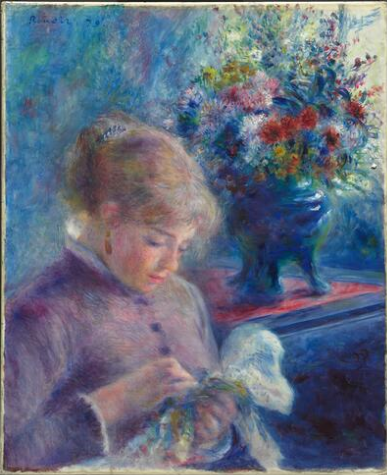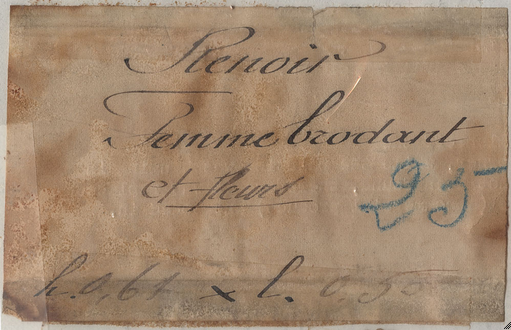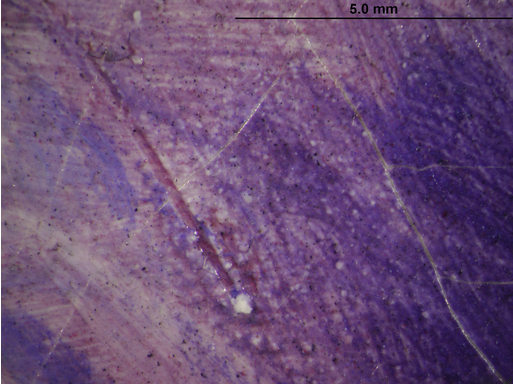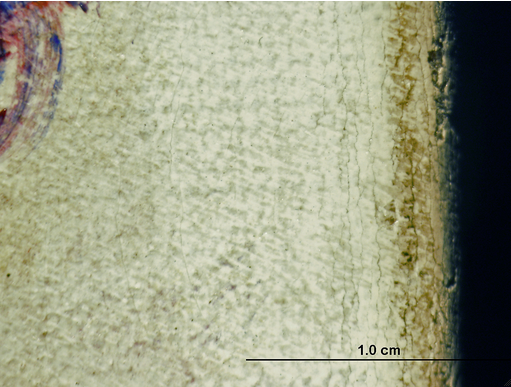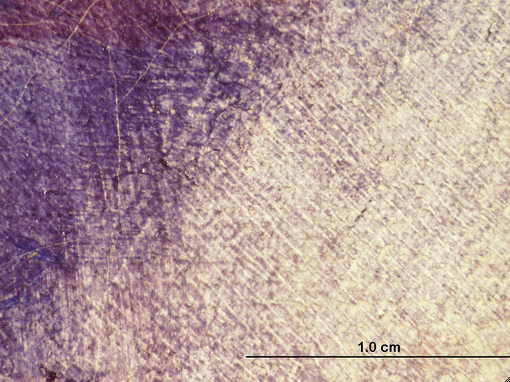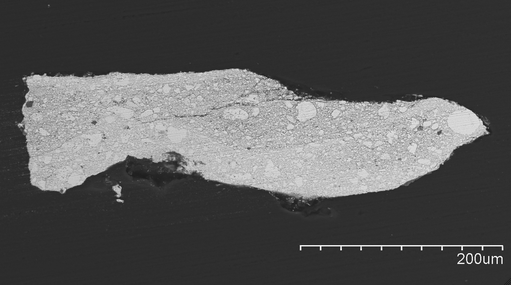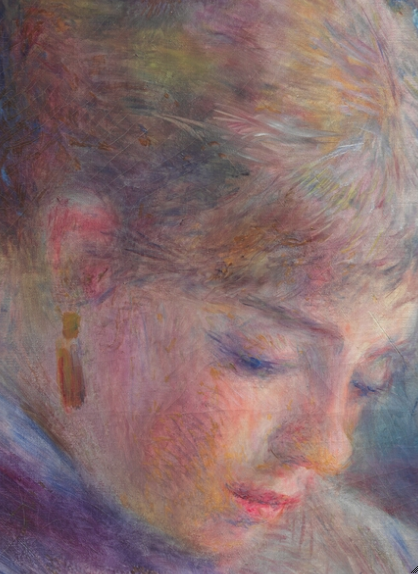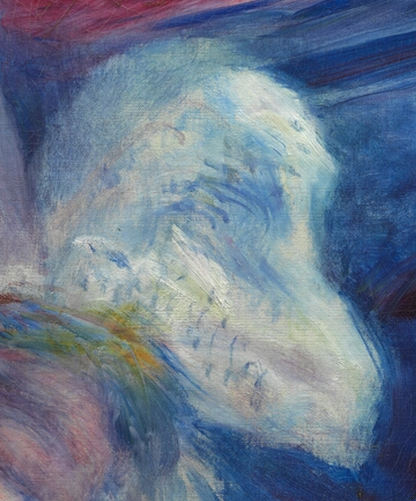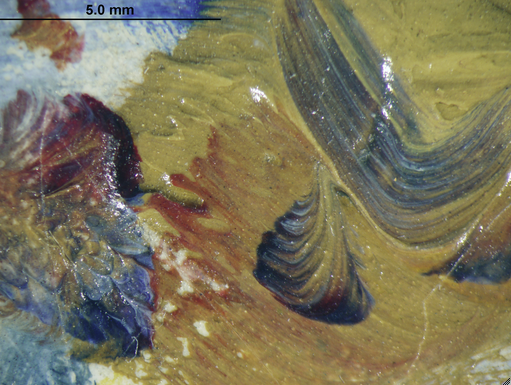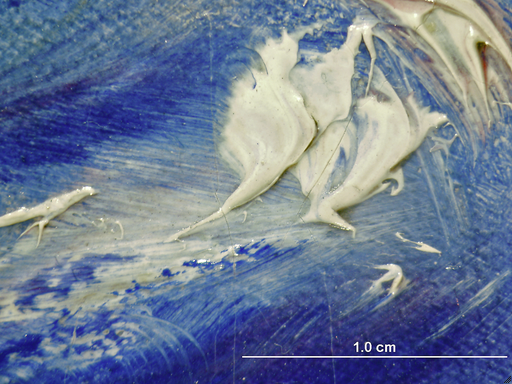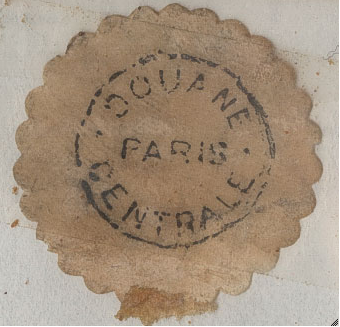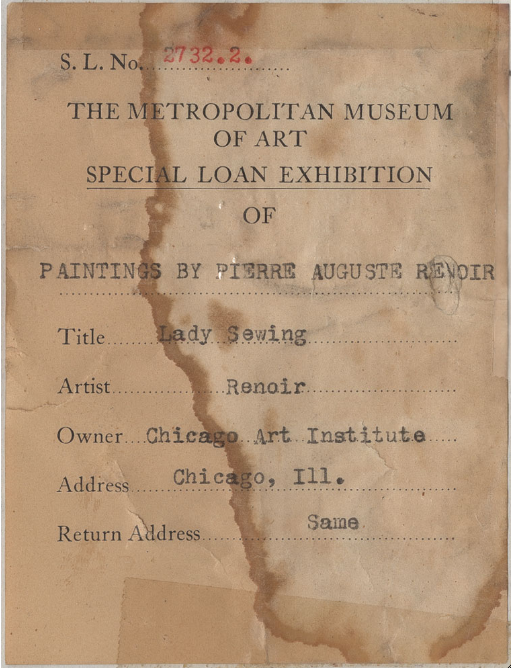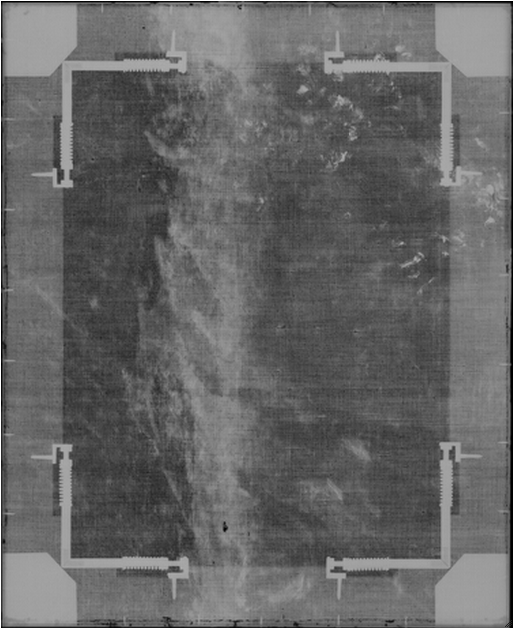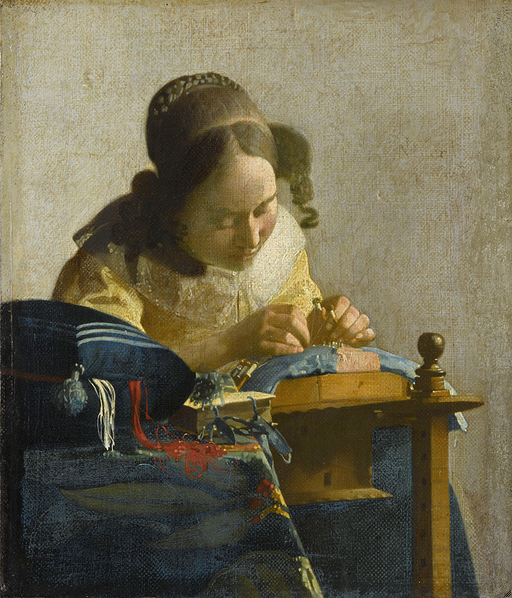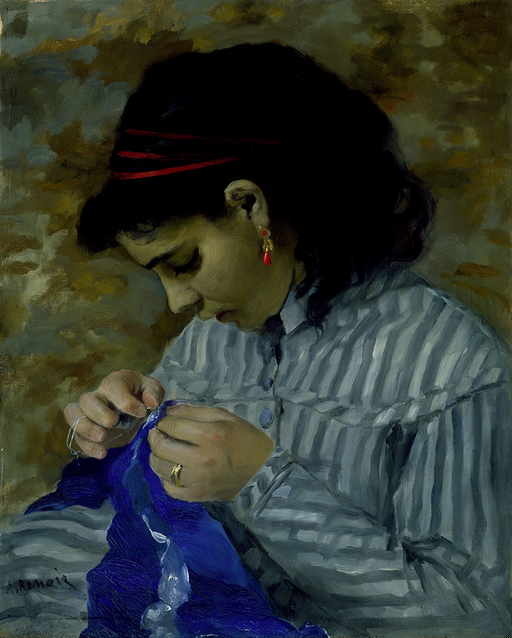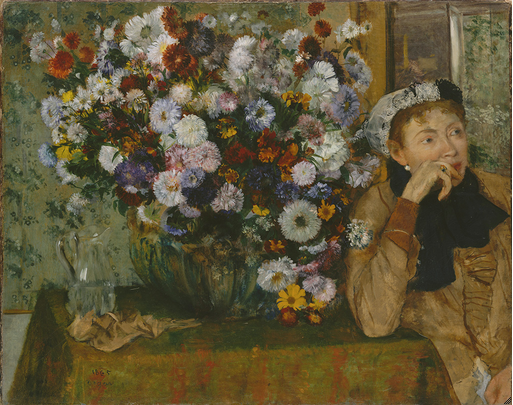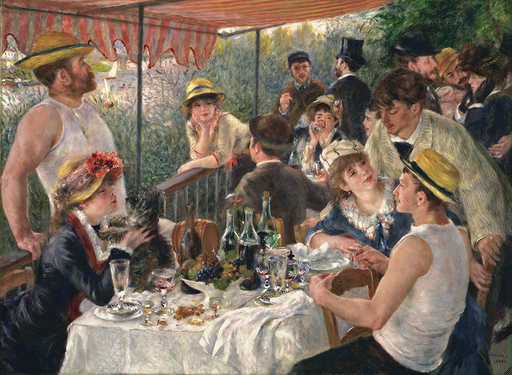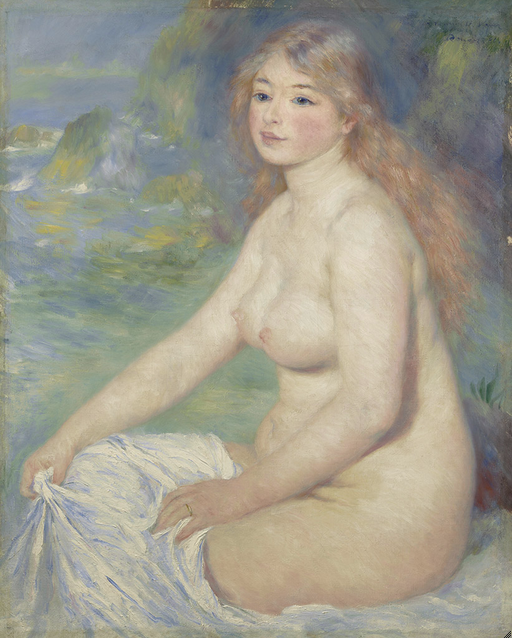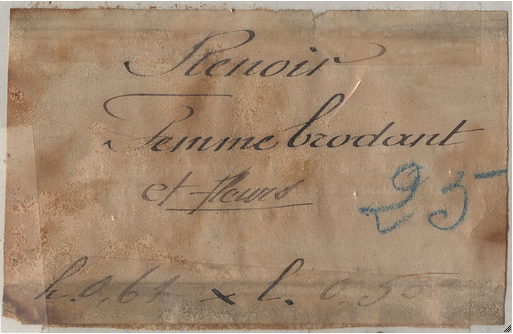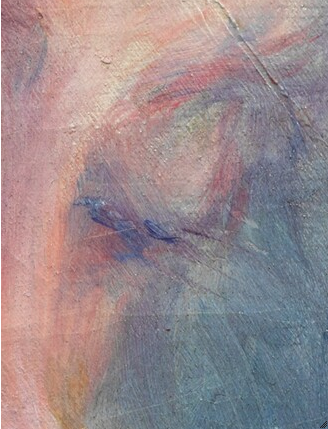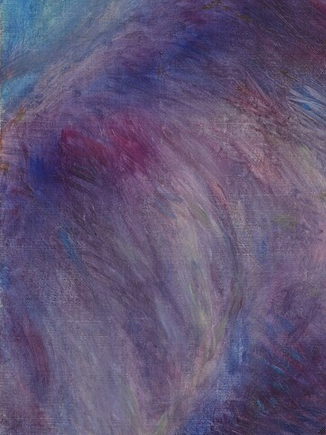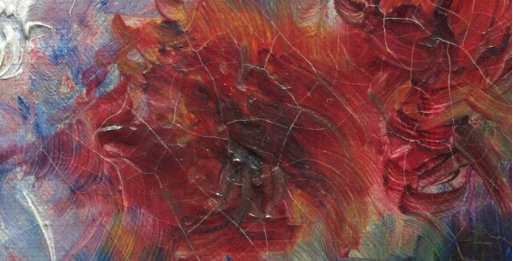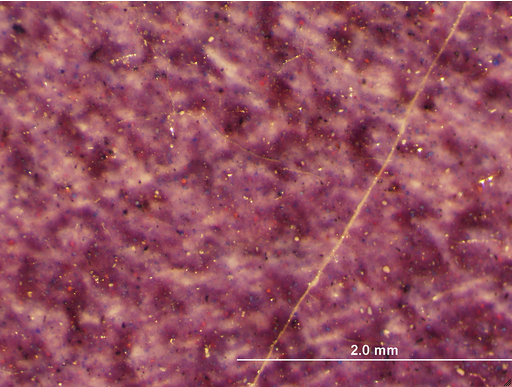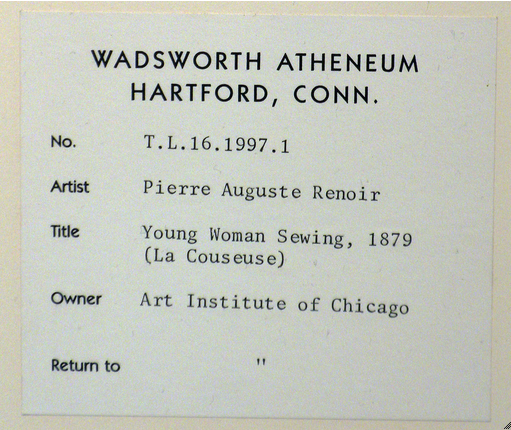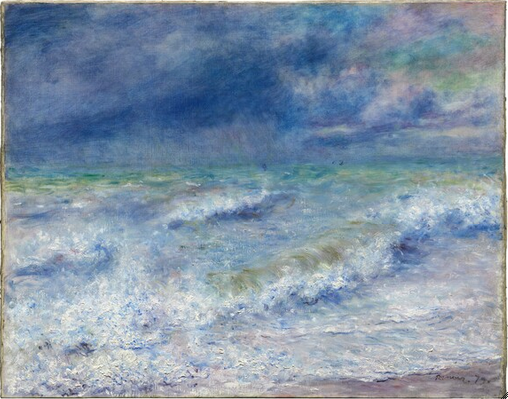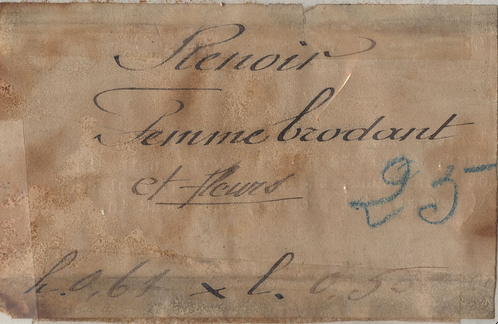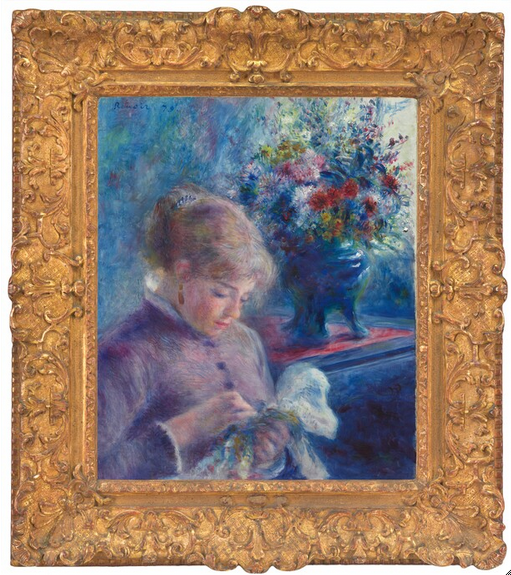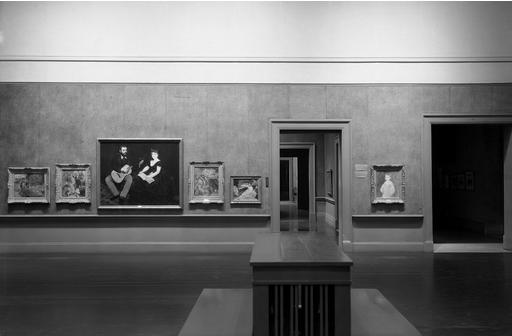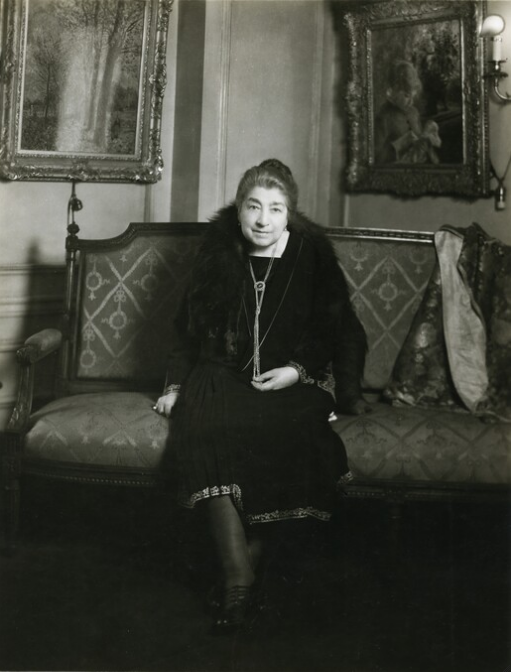Young Woman Sewing as Part of a Tradition
Embroidering and sewing, along with music recitals and reading, feature prominently in Renoir’s repertoire of images depicting the daily life of the French bourgeois woman. The theme is one of a range of domestic genre subjects—also including the governess or servant and child, getting dressed, and playing games—that were carried over into the nineteenth century from past art and given a new sense of contemporaneity and psychological insight by the Realists and the Impressionists. In her biography of the artist, Jeanne Baudot (a student of Renoir’s from 1893 to 1895) reported on a visit to the Musée du Louvre with her mentor: “He particularly liked [Gerard] Terborch and [Pieter] de Hooch, but his favorite was the Lacemaker by Vermeer.” This small oil painting (fig. 7.1) entered the collection of the Louvre in 1870. In Vermeer’s novel treatment of natural light, representation of ephemeral moments of everyday life, and sensitivity to male and female spheres of experience, Renoir found a precedent for his own Impressionist enterprise.
The artist’s earliest representation of needlework, Lise Sewing (fig. 7.2 [Daulte 16; Dauberville 396]), portrays his mistress Lise Tréhot, who modeled for him frequently from 1866 until 1872. In other paintings, Lise played the role of sultry odalisque or nude bather, but here she is represented simply as herself, dressed in modest but elegant attire that is ambiguous as to class. There are signs of staged domesticity in this portrayal. Though unmarried, she wears a wedding ring, and her jeweled earrings with their distinctive teardrop stones may well have been studio props—they reappeared two years later on Lise in Woman in a Garden (1868; Kunstmuseum Basel [Daulte 83; Dauberville 286]). It is worth noting that the figure in Young Woman Sewing also wears teardrop earrings, but the lack of detail makes it difficult to tell whether they are of the same design.
The splendor of the asters and chrysanthemums arranged in a shimmering vase, possibly of glazed ceramic, has led Gloria Groom and Douglas Druick to conclude that Young Woman Sewing was painted late in the summer of 1879 during the final days of Renoir’s first stay at the Château de Wargemont, the Normandy home of his patron Paul Berard. It seems unlikely, however, that the artist would have executed such a large and stunningly provocative color work of an anonymous young woman when his commissioned portraits of the Berard family and staff members are conservatively composed and set against conventional dark backgrounds. Rather, the possibility should be entertained that Young Woman Sewing was executed after Renoir’s return to Paris in late September, where he could have acquired the flowers from one of the many Montmartre flower vendors.
The most remarkable aspect of Young Woman Sewing is the way Renoir was able to energize the traditionally subdued indoor subject with a brilliant flourish of natural light and a profusion of color in the bouquet. His Realist and Impressionist predecessors may have influenced this bold juxtaposition. For example, Gustave Courbet linked women and flowers in The Trellis (fig. 7.3), in which floral bounty verges on the fantastic and makes allegorical allusion to youth and love. Flowers also abound in Edgar Degas’s A Woman Seated beside a Vase of Flowers (fig. 7.4) to such an extent that the off-center figure appears to be a late addition, though this is probably not the case. Rather, Degas seized the opportunity to be visually innovative with the subject. The seemingly informal arrangement of blossoms in Young Woman Sewing dominates the composition less than the flowers in the works by Courbet and Degas, but the abundance of variety and texture allowed Renoir a certain freedom in handling that amply demonstrates his technical skill.
A Possible New Model for Renoir
No attempt has been made to identify Renoir’s beautiful young model with her round face, plump lips, and reddish hair. The artist lost his regular model, Alma-Henriette Leboeuf, called Margot, to smallpox in February 1879 and would have needed another Montmartre resident he could call on for figure paintings. Three additional models posed for Renoir in 1879 and 1880: Ellen Andrée, an aspiring actress; Angèle, a young florist in Montmartre whose last name is not known; and Aline Charigot, Renoir’s future wife. Both Andrée and Charigot had red hair and can be seen in Luncheon of the Boating Party (fig. 7.5 [Daulte 379; Dauberville 224]). Angèle, who appears in Sleeping Girl with a Cat (1880; Sterling and Francine Clark Art Institute, Williamstown, Mass. [Daulte 330; Dauberville 487]), had darker hair and somewhat slimmer facial features.
Though little is known of Aline’s early years in Montmartre or exactly when she met Renoir, it is likely that she had begun modeling for him by the fall of 1879. She was then twenty years old and working as a seamstress, and thus part of a milieu with which Renoir was already acquainted. According to her son Jean Renoir, at the time Aline lived with her mother on rue Saint-Georges, the street on which Renoir’s studio was located. By 1880 Renoir and Aline seem to have been on intimate terms. That summer he paid her board at the Maison Fournaise in Chatou, where she modeled for Luncheon of the Boating Party after Renoir arrived from Normandy in September. If Aline was the model for Young Woman Sewing, the difference between the tranquil concentration and demure costume of the figure in that painting and the coquettish, fashionably dressed canotière (rower) playing with her dog in Luncheon of the Boating Party could reflect Aline’s change in status from occasional model under the watchful eye of her mother to “my dear friend,” as Renoir addressed her in correspondence after their relationship began. In the fall of 1881, Aline accompanied Renoir to Italy. Most scholars agree that, while the couple was in Capri, she modeled for Blonde Bather (fig. 7.6 [Daulte 387; Dauberville 583]). No photographs of Aline from this period of her relationship with Renoir have yet come to light, but there is a compelling resemblance between the figures in Young Woman Sewing and Blonde Bather. Despite the title of the Italian work, there is some red in the woman’s hair, a strawberry-blonde color shared with the figure in Young Woman Sewing. In addition, the two have similar features, including rosy cheeks, wide-set eyes, and prominent noses.
Renoir and Embroidery
It may never be possible to confidently identify Renoir’s model, but Aline’s occupation as a seamstress would have lent additional significance to the artist’s choosing her as a model for this subject. This painting is usually referred to as Young Woman Sewing, or La couseuse, but an early handwritten label from a previous backing or stretcher reads Femme brodant et fleurs (Woman embroidering and flowers; fig. 7.7) and almost certainly dates to the period when Charles Deudon owned the painting, prior to his death in 1914. The brightly colored fabric that the figure holds in her hand suggests that she may be embroidering a pattern on white cloth. The distinction between sewing and embroidery is significant. Repairs to clothing and other fabrics were carried out by domestics or hired out to seamstresses, and undoubtedly Aline undertook such work. Decorative embroidery, however, was reserved for the middle and upper classes and was performed primarily on domestic linens, such as antimacassars and slipcovers, and clothing.
Embroidery acquired even greater status in the late nineteenth century as a form of craft, especially for artists such as Renoir. In 1884, he included embroiderers in his prospectus for a “Société des Irrégularistes,” whose members would also be drawn from the ranks of architects, goldsmiths, and decorators—all professions that shared a belief in the importance of the arts in everyday life. As Gloria Groom has suggested, acknowledging that embroidery was recognized as a craft enriches our understanding of Gustave Caillebotte’s painting of his very haute bourgeoise mother stitching a patterned cloth (1877; private collection). The portrait was shown at the third Impressionist exhibition in April 1877. In July of that year, Caillebotte, Renoir, and the art dealer Alphonse Legrand were collaborators in a business venture to paint decoration on a fine white plaster cement, used to make faux marbre. Though it dissolved in April 1878, the enterprise was indicative of how strongly both Caillebotte and Renoir felt about Impressionism’s involvement in the decorative arts.
Young Woman Sewing as an Exercise in Expressive Color
Young Woman Sewing is a vibrant, light-filled canvas in which Renoir exploited the expressive potential of color with a surprising freedom of handling. Cobalt blue dominates the deep shadows of the legged vase and the body of the commode and is present as well in blended glazes in the background and in the young woman’s costume. The blue makes a striking contrast against the red surface on which the vase sits. Touches of blue applied with a fine-tip brush appear throughout the hair, flesh, comb, and eyelashes (fig. 7.8). Shades of both red and blue run through the woman’s clothing, either applied with long strokes of a fine-tip brush or blended over existing underlayers, and merge into violet in the shadows (fig. 7.9), a velvety Impressionist equivalent of traditional chiaroscuro. With a more sparing use of yellows in the flowers, hair, flesh, and subtle highlights around the vase, Renoir managed to convey middle tones and a convincing verisimilitude through the optical mixing of primary colors (fig. 7.10).
The innovative exploration of color in Young Woman Sewing is evident when the painting is viewed in the context of Renoir’s more conservative portrait painting or compared to a work such as Madame Georges Charpentier and Her Children (fig. 7.11 [Daulte 266; Dauberville 239]), which was exhibited at the Salon of 1879. Renoir clearly considered black an important color and fully understood its aesthetic potential, as indicated by his virtuoso representation of the richly detailed black silk of the luxurious couture dress seen in this painting. By contrast, the dominance of primary hues, especially blue, in Young Woman Sewing makes it the figural equivalent of the stormy Seascape (fig. 7.12 [cat. 8]). The artist established comparable textural patterns in both paintings by juxtaposing areas of translucent color washes with areas of minimally worked impasto. Using the same basic palette, however, Renoir evoked very different moods in the two paintings by varying the representation of light.
The light source in Young Woman Sewing is as ambiguous as that in Vermeer’s Lace Maker. In both paintings, it is presumably a window just outside the space of the picture. The vagueness of the source gave Vermeer latitude to bathe his image in light, giving it a mystical quality. The light in Renoir’s painting can be said to be as much the subject of the piece as the figure’s attentive work with the needle. She radiates warmth, and her features shine with reflected light. The inside of her collar and the top of her head are rendered in pure white, contributing to the intense luminosity of the picture. Even shaded areas away from the light source seem to glow, particularly the figure’s hair (see Palette in the technical report), with its reddish-orange tones (fig. 7.13). Renoir was able to achieve such dazzling effects by using very thin glazes over a thick white ground.
Critics who knew the Impressionists and supported their agenda in the press recognized the fundamental role of color in the group’s work. On the occasion of the second Impressionist exhibition in 1876, Edmond Duranty wrote a pamphlet titled The New Painting, which provided a justification for the kinds of issues Renoir sought to address in Young Woman Sewing: “Proceeding from intuition to intuition, they have little by little succeeded in breaking down sunlight into its rays, its elements, and [in] reconstituting its unity by means of the general harmony of spectrum colors—which they spread on their canvases.” Young Woman Sewing holds an important place in Renoir’s oeuvre not only by virtue of its subject matter, drawn from the Old Masters, but also because it reveals Renoir forging his independence as a modern colorist even as he sought greater commercial success at the Salon.
John Collins
Technical Report
Technical Summary
Renoir executed this painting on a fine-weave, standard-size [glossary:canvas] with a thick, white, commercially applied ground that fills the [glossary:weave], appears systematically textured with diagonal strokes, and extends to the edges of the [glossary:tacking margins]. The [glossary:X-ray] shows a large vertical form left of center that does not correspond to any visible element in the painting; it seems to be an artifact of an imperfectly applied [glossary:ground] layer.
In most of the composition, Renoir layered thin veils of paint in glaze- and semiglaze-like layers in order to make use of the reflective qualities of the ground. To achieve this translucency, he alternately thinned and added fluid medium to his paint and used translucent [glossary:pigments] like red lake and cobalt blue. Some parts of the background and figure are so thin that they do not register in the X-ray, in contrast with the thicker, heavily textured application of paint in the flowers on the upper right. The artist appears to have made few compositional changes to the work, perhaps only lowering the profile of the woman’s right shoulder. The slightly shaded look of the area immediately to the right of the figure may also indicate changes to either the figure or the background that Renoir subsequently wiped away with a cloth, leaving a thin residue behind. In the foreground, the artist employed wiping as a painting technique; the remnants of paint left in the depressions of the textured ground create shadow and give the gathered fabric in the woman’s hand a soft edge. Toward the end of the process, Renoir firmly established the light source on the upper right with heavy white highlights on the vase and flowers, and in the comb in the figure’s hair.
The work has a [glossary:synthetic varnish] that imparts some saturation and gloss. The current [glossary:varnish] replaced an oil-resin varnish, but it is unknown whether that was original to the painting.
Multilayer Interactive Image Viewer
The multilayer interactive image viewer is designed to facilitate the viewer’s exploration and comparison of the technical images (fig. 7.14).
Signature
Signed and dated: Renoir. 79. (upper left, in blue paint).
The signature was painted [glossary:wet-in-wet] with the upper layers of the background and picks up some of the surrounding red lake through the center. The n appears to have been reinforced by the artist during the process (fig. 7.15, fig. 7.16).
Structure and Technique
Support
Canvas
Flax (commonly known as linen).
Standard Format
The original dimensions of the canvas were 61.1 × 50.2 cm, according to 1969 pretreatment measurements. An early exhibition label preserved from the original [glossary:stretcher] lists the painting as 61 × 50 cm (fig. 7.17), and a possibly related published exhibition record from 1922 lists the same measurements. This probably corresponds to a no. 12 portrait ([glossary:figure]) standard-size (60 × 50 cm) canvas.
Weave
[glossary:Plain weave]. Average [glossary:thread count] (standard deviation): 29.8V (0.5) × 24.9H (1.2) threads/cm. The vertical threads were determined to correspond to the [glossary:warp] and the horizontal threads to the [glossary:weft].
Canvas characteristics
There is very mild [glossary:cusping] corresponding to the placement of the original tacks. The canvas is also marked by numerous nubs and imperfections.
Stretching
Current stretching: When the painting was lined in 1969, the original dimensions were slightly increased on all sides (see Conservation History).
Original stretching: Based on cusping visible in the X-ray, the original tacks were placed approximately 4.5–6.5 cm apart.
Stretcher/strainer
Current stretcher: Four-member ICA spring stretcher. Depth: 2.5 cm.
Original stretcher: Five-member keyable stretcher with horizontal [glossary:crossbar]. Depth: Approximately 1.5 cm.
Manufacturer’s/supplier’s marks
Stamp
Location: verso of original canvas (covered by lining)
Method: stamp
Content: C[OU]LEURS FINES TOILES PEINDRE / TABLEAUX / REY & PERROD / [5]1 Rue de la Rochefou[cauld] / PARIS (fig. 7.18)
Preparatory Layers
Sizing
Not determined (probably glue).
Ground application/texture
The canvas was prepared with a white ground that extends to the edges of the tacking margins and fills the fine canvas weave. The thickness of the [glossary:priming], averaging approximately 50–100 µm, suggests that there may have been multiple applications. [glossary:Cross-sectional analysis] indicates that the preparation is probably a double layer, with both layers of very similar composition and the second applied shortly after the first. The X-ray shows an apparent buildup of paint or ground material in a vertical section just left of center that does not correspond to any visible element in the painting. The haphazard, sometimes sharp-edged marks seen in the X-ray may indicate application of a (perhaps localized) preparatory layer with a [glossary:palette knife] (fig. 7.19). Toward the edges of this area, especially near the top, brushstrokes are visible, suggesting that this layer may initially have been applied with a palette knife, then worked into the surface with a brush. This layer also looks different from the surrounding areas: it is more heavily and unevenly textured and contains a number of large lead-containing protrusions (fig. 7.20). Elsewhere on the surface, however, a shallow, fine, diagonal texture can be seen, which may mean that the upper layer was applied or finished with a brush (fig. 7.21). This texture appears to go to the edges of the tacking margins, passing over the foldover on all sides. As the weave is very fine, such a thick ground application, had it been applied with a palette knife alone, would have resulted in an extremely smooth, almost glassy surface. Adding a systematic texture to the upper layer allowed the surface to hold more paint, something especially important in this work because the paint layers are so thin.
Reasons for the localized application of additional priming left of center are unclear. There are small scratches in the ground layers (visible in the X-ray as diagonal marks on the lower and center left) that seem to have occurred before the work was painted and possibly before the additional ground layer was applied. It is possible that the extra material was added to cover these marks. The increased texture in this area makes the colors appear darker, because of increased saturation as the thin, translucent paint layers sank into the depressions, pooling more thickly and thus appearing more intense. These darker areas where the paint has pooled more thickly do not correspond to, cover, or accentuate compositional forms; therefore, it is unlikely that this was an intentional effect desired or requested by the artist. However, Renoir would have been aware of the effect immediately, and while he may not have intended it, there is no evidence that he made any attempt to diminish it.
The ground is exposed throughout the painting, especially on the upper right. In many areas, the paint layers are very thin, allowing the lightness and texture of the ground to show through (fig. 7.22).
Color
Careful stereomicroscopic examination of the surface indicates a bright white ground with very few dark or colored particles visible (fig. 7.23).
Materials/composition
The commercial ground appears to be a double application of priming material containing predominantly lead white with barium sulfate and variable trace amounts of silica; calcium-based white; silicate minerals with associated iron oxides, including umber; alumina; and small particles of ultramarine blue. The area of apparent additional preparation, just left of center, was found to have the same composition. The [glossary:binder] is estimated to be [glossary:oil]; the upper layer of the ground application looks less dense in the backscattered electron ([glossary:BSE]) image, which may indicate that this layer contains slightly more medium (fig. 7.24).
Compositional Planning/Underdrawing/Painted Sketch
No [glossary:underdrawing] was observed with [glossary:infrared reflectography] or under microscopic examination.
Paint Layer
Application/technique and artist’s revisions
The primary technique Renoir employed in making this painting was to layer very thin, translucent veils of paint in order to make use of the reflective qualities of the white ground. On the upper right, he left the ground mostly exposed to hint at the light source. On the left, the paint layers that make up the woman and her costume are so thin that they are not readily visible in the X-ray (fig. 7.19). The X-ray does show a few of the highly textured flower petals and white highlights, in addition to an apparent buildup of ground material as a vertical form left of center. To create the flesh tones, the artist mixed red lake and cobalt blue, sometimes with a small amount of yellow or vermilion, but generally without white, layering the colors so thinly that the highlights and glow of the flesh are largely a result of light reflecting off of the priming (fig. 7.25).
Renoir both thinned and added fluid medium to his paints to achieve translucent washes and glazes. The thinness of the underlying washes is apparent throughout the background and contrasts with the more glaze-like handling of the figure’s dress and flesh tones (fig. 7.26). In some areas, the artist used a cloth to wipe paint away, leaving only a small amount in the depressions of the canvas weave. This technique can be seen in the cloth the woman holds in the foreground, where the shadow across the top curve is indicated by the residue of blue paint that has been largely wiped away (fig. 7.27). Renoir may also have employed this technique in the underlayers throughout the figure, especially in her hair and costume. The only obvious indication of a change to the figure is along the top of the woman’s right shoulder, which appears to have been slightly lowered before it was fully defined. Because the paint layers are so thin, evidence of this change is still visible on the left (fig. 7.28). The somewhat darkened appearance of the paint immediately to the right of the figure suggests that the artist made additional changes and wiped away some paint; however, the nature and subject of these changes are unclear.
In contrast to his handling of the rest of the picture, Renoir built up the flowers on the upper right with thicker paint and small dabs of heavy [glossary:impasto] (fig. 7.29). As a final touch, the artist added highlights in pure white on the vase (fig. 7.30) and on the comb holding the figure’s hair (fig. 7.31) to clarify the light source on the upper right.
Painting tools
Very fine, round brushes, some with wider strokes up to 1 cm wide; cloth for wiping.
Palette
Analysis indicates the presence of the following [glossary:pigments]: lead white, cobalt blue, iron oxide red, vermilion, madder lake, bone black, zinc yellow, chrome yellow, strontium yellow, and possibly barium yellow.
Stereomicroscopic examination and cross-sectional analysis indicate that the dull yellow, almost ocher-colored paint used in some of the flowers and in the gathered fabric in the foreground is not the common earth pigment, but a complex mixture including zinc yellow, black, and madder lake (fig. 7.32).
The observation of a characteristic orange [glossary:fluorescence] under UV light indicates that the artist used large amounts of fluorescing red lake, identified as madder lake, mixed with other colors to create the flesh tones, hair, and costume (fig. 7.33). In the UV image, the tabletop on the right appears to be painted almost entirely with this lake color (fig. 7.34).
Binding media
Oil (estimated).
Surface Finish
Varnish layer/media
The current synthetic varnish was applied during the 1969 treatment and replaced an oil-resin varnish. There are residues of this earlier varnish around areas of impasto (especially the signature). It is unknown whether this varnish was original to the painting; however, abrasion noted in the pretreatment report suggests that the painting had been cleaned previously (see Conservation History).
Conservation History
The painting’s only documented treatment was a 1969 [glossary:lining]. Grime and a discolored oil-resin varnish were removed, and the work was taken off of its original stretcher. The painting was faced with mulberry-fiber paper and starch paste and wax-resin lined to a secondary piece of linen. The lined painting was restretched on an ICA spring stretcher of slightly larger dimensions, leaving a margin of exposed ground around the perimeter. The work was inpainted and given three coats of synthetic varnish (an isolating layer of polyvinyl acetate [PVA] AYAA, followed by [glossary:inpainting], a layer of methacrylate resin L-46, and a final coat of AYAA).
Condition Summary
The work is in good condition, planar with a stable [glossary:wax-resin lining]. Heavy [glossary:craquelure] can be seen throughout the work, especially in [glossary:raking light], and includes stretcher-bar marks corresponding to the original stretcher. There is a small loss along the line of buttons just under the figure’s left hand and a loss of impasto in the flowers to the right of her hair. Long diagonal creases, which extend from the left edge behind the figure’s head down toward her hands, seem to have occurred during the preparation of the canvas, and original paint settled into the depressions associated with them. The inpainting is discolored and visible in many areas of the face, hair, and hands, and around the edges. In most cases, the [glossary:retouching] addresses areas of abrasion and traction cracking. The work has a synthetic varnish imparting even saturation and gloss; there are two large, matte surface drips in the lower left quadrant.
Kelly Keegan
Frame
The current frame appears to be original to the painting. It is a French, late-nineteenth–early-twentieth-century, Louis XIV reproduction, gilt ogee frame with cast plaster anthemia corner cartouches and fleur-de-lis center cartouches, linked by fleurs-de-lis surrounded by scrolls and strapwork. The frame has oil and water gilding over red bole on cast plaster and gesso. The ornament and sight molding are selectively burnished. The gilding is heavily rubbed and toned with a casein or gouache raw umber wash with a gray overwash and dark flecking. The pine molding is mitered and nailed. At some point in the frame’s history, the original verso was planed flat, removing all construction history and provenance, a back frame was added, and all back and interior surfaces were painted. The molding, from the perimeter to the interior, is torus with dentil outer molding; scotia side; ogee face with anthemia corner cartouches and fleur-de-lis center cartouches on diamond-punched beds, linked by fleurs-de-lis surrounded by foliate scrolls and strapwork on a quadrillage bed; sanded front frieze bordered with fillets; and ogee sight molding with leaf-tip ornament linked by scrolls and strapping on a recut bed (fig. 7.35, fig. 7.36).
Kirk Vuillemot
Provenance
Acquired from [unknown] by Charles Deudon (died 1914), Paris and Nice.
Acquired by Paul Rosenberg and Co., Paris and New York, by Feb. 1921.
Acquired by Howard Young, New York.
Acquired by Mrs. Lewis Larned (Annie Swan) Coburn, Chicago, by June 1931.
Bequeathed by Mrs. Lewis Larned (Annie Swan) Coburn (died 1932) to the Art Institute of Chicago, 1933.
Exhibition History
Paris, Paul Rosenberg, Exposition d’oeuvres de grands maîtres du dix-neuvième siècle, May 3–June 3, 1922, cat. 74.
Art Institute of Chicago, Exhibition of the Mrs. L. L. Coburn Collection: Modern Paintings and Watercolors, Apr. 6–Oct. 9, 1932, cat. 32.
Art Institute of Chicago, “A Century of Progress”: Loan Exhibition of Paintings and Sculpture, May 23–Nov. 1, 1933, cat. 344. (fig. 7.37)
Art Institute of Chicago, “A Century of Progress”: Loan Exhibition of Paintings and Sculpture for 1934, June 1–Oct. 31, 1934, cat. 235.
New York, Metropolitan Museum of Art, Renoir: A Special Exhibition of His Paintings, May 18–Sept. 12, 1937, cat. 25 (ill.).
Columbus (Ohio) Gallery of Fine Arts, Six Paintings by Renoir, Oct. 6–Nov. 6, 1938, cat. 1 (ill.).
New York, Paul Rosenberg, Great French Masters of the Nineteenth Century: Corot to van Gogh, May 4–29, 1942, cat. 8 (ill.).
Art Gallery of Toronto, Fifty Paintings by Old Masters, Apr. 21–May 21, 1950, cat. 37.
New York, Wildenstein, Renoir: A Loan Exhibition for the Benefit of the American Association of Museums in Commemoration of the Fiftieth Anniversary of Renoir’s Death, Mar. 27–May 3, 1969, cat. 28 (ill.).
Art Institute of Chicago, Paintings by Renoir, Feb. 3–Apr. 1, 1973, cat. 25 (ill.).
Tokyo, National Museum of Western Art, Masterpieces of World Art from American Museums: From Ancient Egyptian to Contemporary Art, Sept. 11–Oct. 17, 1976, cat. 45 (ill.); Kyoto National Museum, Nov. 2–Dec. 5, 1976.
Ann Arbor, University of Michigan Museum of Art, The Crisis of Impressionism, 1878–1882, Nov. 2, 1979–Jan. 6, 1980, cat. 47 (ill.).
Albi, Musée Toulouse-Lautrec, Trésors impressionnistes du Musée de Chicago, June 27–Aug. 31, 1980, cat. 20 (ill.).
Hartford, Conn., Wadsworth Atheneum Museum of Art, June 27, 1997–May 6, 1998, no cat.
Tokyo, Seiji Togo Memorial Yasuda Kasai Museum of Art, Aug. 24, 2001–June 12, 2002, no cat.
Fort Worth, Tex., Kimbell Art Museum, The Impressionists: Master Paintings from the Art Institute of Chicago, June 29–Nov. 2, 2008, cat. 29 (ill.).
Tokyo, National Art Center, Renoir: Tradition and Innovation, Jan. 20–Apr. 5, 2010, cat. 54 (ill.); Osaka, National Museum of Art, Apr. 17–June 27, 2010.
Selected References
“La curiosité: La collection Deudon,” Le bulletin de la vie artistique 1, 11 (May 1, 1920), p. 306 (ill.).
Jacques-Émile Blanche, “La technique de Renoir,” L’amour de l’art 2, 2 (Feb. 1921), opp. p. 33 (ill.).
Paul Rosenberg, Paris, Exposition d’oeuvres de grands maîtres du dix-neuvième siècle, exh. cat. (Frazier-Soye, 1922), p. 23, cat. 74.
Julius Meier-Graefe, Renoir (Klinkhardt & Biermann, 1929), pp. 99, n. 1; 122, no. 108 (ill.).
“French Masterpieces That One Day Will Belong to Art Institute,” Chicago Daily News, June 1931, p. 14 (ill.).
Reginald Howard Wilenski, French Painting (Hale, Cushman & Flint, 1931), p. 262.
Art Institute of Chicago, Exhibition of the Mrs. L. L. Coburn Collection: Modern Paintings and Watercolors, exh. cat. (Art Institute of Chicago, 1932), pp. 6; 22–23, no. 32.
Daniel Catton Rich, “The Bequest of Mrs. L. L. Coburn,” Bulletin of the Art Institute of Chicago 26, 6 (Nov. 1932), p. 68.
Art Institute of Chicago, Catalogue of “A Century of Progress”: Exhibition of Paintings and Sculpture; Lent from American Collections, ed. Daniel Catton Rich, 3rd ed., exh. cat. (Art Institute of Chicago, 1933), p. 49, cat. 344.
Art Institute of Chicago, “The Rearrangement of the Paintings Galleries,” Bulletin of the Art Institute of Chicago 27, 7 (Dec. 1933), p. 115.
Art Institute of Chicago, Catalogue of “A Century of Progress”: Exhibition of Paintings and Sculpture, 1934, ed. Daniel Catton Rich, exh. cat. (Art Institute of Chicago, 1934), pp. 39–40, cat. 235.
Art Institute of Chicago, A Brief Illustrated Guide to the Collections (Art Institute of Chicago, 1935), p. 28.
Hans Tietz, ed., Meisterwerke europäischer Malerei in Amerika (Phaidon, 1935), pp. 295 (ill.), p. 345.
Metropolitan Museum of Art, Renoir: A Special Exhibition of His Paintings, exh. cat. (Metropolitan Museum of Art/Bradford, 1937), no. 25 (ill.).
Harry B. Wehle, “The Painting of Renoir,” in Metropolitan Museum of Art, Renoir: A Special Exhibition of His Paintings, exh. cat. (Metropolitan Museum of Art/Bradford, 1937), p. 7.
Josephine L. Allen, “Paintings by Renoir,” Bulletin of the Metropolitan Museum of Art 32, 5 (May 1937), p. 112.
Columbus (Ohio) Gallery of Fine Arts, “Six Paintings by Renoir,” Monthly Bulletin 9, 1 (Oct. 1938), front cover (ill.); no. 1.
Lionello Venturi, Les archives de l’impressionnisme: Lettres de Renoir, Monet, Pissarro, Sisley, et autres; Mémoires de Paul Durand-Ruel; Documents, vol. 1 (Durand-Ruel, 1939), p. 152.
Reginald Howard Wilenski, Modern French Painters (Reynal & Hitchcok, [1940]), pp. 62, 337.
Harry B. Wehle, “The Painting of Renoir,” in Duveen Galleries, New York, Renoir: Centennial Loan Exhibition, 1841–1941; For the Benefit of the Free French Relief Committee, exh. cat. (Vilmorin/Bradford, 1941), p. 18.
Paul Rosenberg, New York, Great French Masters of the Nineteenth Century: Corot to Van Gogh, exh. cat. (Rosenberg, 1942), pp. 24–25, no. 8 (ill.).
Art Institute of Chicago, An Illustrated Guide to the Collections of the Art Institute of Chicago (Art Institute of Chicago, 1945), p. 36.
Isabel Bishop, “Concerning Edges,” Magazine of Art 38, 5 (May 1945), p. 172 (ill.).
Art Institute of Chicago, “Bulletin Board,” Bulletin of the Art Institute of Chicago 40, 1 (Jan. 1946), p. 6.
Art Institute of Chicago, “Bulletin Board,” Bulletin of the Art Institute of Chicago 40, 4, pt. 2 (Apr.–May 1946), p. 52.
“What the Piece Goods Buyer Can Learn from the Apparel Business,” American Fabrics 4 (Fall 1947), p. 88 (ill.).
Art Gallery of Toronto, Fifty Paintings by Old Masters, exh. cat. (Art Gallery of Toronto, 1950), cat. 37.
Dorothy Bridaham, Renoir in the Art Institute of Chicago (Conzett & Huber, 1954), pl. 2.
Art Institute of Chicago, Paintings in the Art Institute of Chicago: A Catalogue of the Picture Collection (Art Institute of Chicago, 1961), p. 395.
Frederick A. Sweet, “Great Chicago Collectors,” Apollo 84, 55 (Sept. 1966), p. 203.
François Daulte, Renoir: A Loan Exhibition for the Benefit of the American Association of Museums in Commemoration of the Fiftieth Anniversary of Renoir’s Death, exh. cat. (Wildenstein, 1969), cat. 28 (ill.).
François Daulte, Auguste Renoir: Catalogue raisonné de l’oeuvre peint, vol. 1, Figures, 1860–1890 (Durand-Ruel, 1971), pp. 230–31, cat. 299 (ill.).
Elda Fezzi, L’opera completa di Renoir: Nel periodo impressionista, 1869–1883, Classici dell’arte 59 (Rizzoli, 1972), pp. 103, cat. 339; 104, cat. 339 (ill.).
Art Institute of Chicago, Paintings by Renoir, exh. cat. (Art Institute of Chicago, 1973), pp. 78–79, cat. 25 (ill.).
National Museum of Western Art, Tokyo, and Kyoto National Museum, Masterpieces of World Art from American Museums: From Ancient Egyptian to Contemporary Art, exh. cat. (National Museum of Western Art, Tokyo, 1976), no. 45 (ill.).
Patricia Erens, Masterpieces: Famous Chicagoans and Their Paintings (Chicago Review, 1979), n. pag. (ill.).
J. Patrice Marandel, The Art Institute of Chicago: Favorite Impressionist Paintings (Cross River, 1979), pp. 72–73 (ill.).
Joel Isaacson, The Crisis of Impressionism, 1878–1882, exh. cat. (University of Michigan Museum of Art, 1980), pp. 30; 178–79, cat. 47 (ill.).
Diane Kelder, The Great Book of French Impressionism (Abbeville, 1980), pp. 266 (ill.), 438.
Diane Kelder, The Great Book of French Impressionism, Tiny Folios (Abbeville, 1980), p. 148, pl. 8.
Musée Toulouse-Lautrec and Art Institute of Chicago, Trésors impressionnistes du Musée de Chicago, exh. cat. (Musée Toulouse-Lautrec, 1980), pp. 39, no. 20 (ill.); 68.
Nicholas Wadley, ed., Renoir: A Retrospective (Hugh Lauter Levin/Macmillan, 1987), p. 66, pl. 18.
Anne Distel, “Charles Deudon (1832–1914) collectionneur,” Revue de l’art 86 (1989), p. 64, no. 10 (ill.).
Sophie Monneret, Renoir, Profils de l’art (Chêne, 1989), p. 152, cat. 23 (ill.).
Art Institute of Chicago, Treasures of 19th- and 20th-Century Painting: The Art Institute of Chicago, with an introduction by James N. Wood (Art Institute of Chicago/Abbeville, 1993), p. 77 (ill.).
Douglas W. Druick, Renoir, Artists in Focus (Art Institute of Chicago/Abrams, 1997), pp. 45–46; 88, pl. 7; 110.
Gilles Néret, Renoir: Painter of Happiness, 1841–1919, trans. Josephine Bacon (Taschen, 2001), pp. 124–25 (ill.).
John Collins, “Christine Lerolle Embroidering: Between Genre Painting and Portraiture,” in Ann Dumas and John Collins, Renoir’s Women, exh. cat. (Columbus Museum of Art/Merrell, 2005), pp. 102, 106.
Guy-Patrice Dauberville and Michel Dauberville, with the collaboration of Camille Frémontier-Murphy, Renoir: Catalogue raisonné des tableaux, pastels, dessins et aquarelles, vol. 1, 1858–1881 (Bernheim-Jeune, 2007), pp. 416–17, cat. 393 (ill.).
Gloria Groom and Douglas Druick, with the assistance of Dorota Chudzicka and Jill Shaw, The Impressionists: Master Paintings from the Art Institute of Chicago, exh. cat. (Art Institute of Chicago/Kimbell Art Museum, 2008), pp. 15 (ill.); 76, cat. 29 (ill.). Simultaneously published as Gloria Groom and Douglas Druick, with the assistance of Dorota Chudzicka and Jill Shaw, The Age of Impressionism at the Art Institute of Chicago (Art Institute of Chicago/Yale University Press, 2008), pp. 15 (ill.); 76, cat. 29 (ill.).
Anne Distel, Renoir (Citadelles & Mazenod, 2009), pp. 154–55, ill. 138.
Toru Arayashiki et al., Renoir: Tradition and Innovation, trans. Stanley N. Anderson, Martha J. McClintock, and Cheryl A. Silverman, exh. cat. (National Museum of Art, Osaka/National Art Center, Tokyo/Yomiuri Shimbun, 2010), pp. 25 (ill.); 146–47, cat. 54 (ill.); 148–49 (detail); 249, cat. 54 (ill.).
Other Documentation
Labels and Inscriptions
Pre-1980
Stamp
Location: verso of original canvas (covered by lining)
Method: stamp
Content: C[OU]LEURS FINES TOILES PEINDRE / TABLEAUX / REY & PERROD / [5]1 Rue de la Rochefou[cauld] / PARIS (fig. 7.18)
Label
Location: previous stretcher or backing (discarded); preserved in conservation file
Method: handwritten script on white label
Content: Renoir / Femme brodant / et fleurs / h. 0,61 × l. 0,50 / [center right, blue script] 25 (fig. 7.38)
Label
Location: previous stretcher or backing (discarded); preserved in conservation file
Method: stamp on round label
Content: DOUANE / PARIS / CENTRALE (fig. 7.39)
Label
Location: previous stretcher or backing (discarded); preserved in conservation file
Method: printed and typed label
Content: S. L. No. 2732.2. / THE METROPOLITAN MUSEUM / OF ART / SPECIAL LOAN EXHIBITION / OF / PAINTINGS BY PIERRE AUGUSTE RENOIR / Title Lady Sewing / Artist Renoir / Owner Chicago Art Institute / Address Chicago, Ill. / Return Address Same (fig. 7.40)
Number
Location: stretcher
Method: handwritten script (black marker)
Content: 33.452 (fig. 7.41)
Label
Location: previous backing (discarded); transcription preserved in curatorial file
Method: printed label
Content: Le Musee National d’art Occidental / Tokyo, Japan / cat. no. 45
Post-1980
Stamp
Location: stretcher
Method: blue stamp
Content: Inventory—1980–1981 (fig. 7.42)
Label
Location: backing board
Method: typed label
Content: THE ART INSTITUTE OF CHICAGO / artist Pierre Auguste Renoir / title Lady Sewing / medium oil on canvas / credit Mr.&Mrs. Lewis Lanard [sic] Coburn Collection / acc. # 1933.452 / LZ-341-001 1M 1/90 (Rev. 1/90) (fig. 7.43)
Label
Location: backing board
Method: typed label
Content: WADSWORTH ATHENEUM / HARTFORD, CONN. / No. T.L.16.1997.1 / Artist Pierre Auguste Renoir / Title Young Woman Sewing, 1879 / (La Couseuse) / Owner Art Institute of Chicago / Return to " (fig. 7.44)
Examination and Analysis Techniques
X-radiography
Westinghouse X-ray unit, scanned on Epson Expressions 10000XL flatbed scanner. Scans were digitally composited by Robert G. Erdmann, University of Arizona.
Infrared Reflectography
Inframetrics Infracam with 1.5–1.73 µm filter; Fujifilm S5 Pro with X-Nite 1000B/2 mm filter (1.0–1.1 µm); Goodrich/Sensors Unlimited SU640SDV-1.7RT with H filter (1.1–1.4 µm) and J filter (1.5–1.7 µm).
Transmitted Infrared
Fujifilm S5 Pro with X-Nite 1000B/2 mm filter (1.0–1.1 µm).
Visible Light
Natural-light, raking-light, and transmitted-light overalls and macrophotography: Fujifilm S5 Pro with X-NiteCC1 filter.
Ultraviolet
Fujifilm S5 Pro with X-NiteCC1 filter and Kodak Wratten 2E filter.
High-Resolution Visible Light (and Ultraviolet)
Sinar P3 camera with Sinarback eVolution 75 H (X-NiteCC1 filter and Kodak Wratten 2E filter).
Microscopy and Photomicrographs
Sample and cross-sectional analysis were performed using a Zeiss Axioplan2 research microscope equipped with reflected light/UV fluorescence and a Zeiss AxioCam MRc5 digital camera. Types of illumination used: darkfield, differential interference contrast (DIC), and UV. In situ photomicrographs were taken with a Wild Heerbrugg M7A StereoZoom microscope fitted with an Olympus DP71 microscope digital camera.
X-ray Fluorescence Spectroscopy (XRF)
Several spots on the painting were analyzed in situ with a Bruker/Keymaster TRACeR III-V with rhodium tube.
Polarized Light Microscopy (PLM)
Zeiss Universal research microscope.
Scanning Electron Microscopy/Energy-Dispersive X-ray Spectroscopy (SEM/EDX)
Cross sections were analyzed after carbon coating with a Hitachi S-3400N-II VPSEM with an Oxford EDS and a Hitachi solid-state BSE detector. Analysis was performed at the Northwestern University Atomic and Nanoscale Characterization Experimental (NUANCE) Center, Electron Probe Instrumentation Center (EPIC) facility.
Surface-Enhanced Raman Spectroscopy (SERS)
A Jobin Yvon Horiba LabRAM 300 confocal Raman microscope was used, equipped with an Andor multichannel, Peltier-cooled, open-electrode charge-coupled device detector (Andor DV420-OE322; 1024×256), an Olympus BXFM open microscope frame, a holographic notch filter, and an 1,800-grooves/mm dispersive grating.
The excitation line of an air-cooled, frequency-doubled, He-Ne laser (632.8 nm) was focused through a 20× objective onto the samples, and Raman scattering was back collected through the same microscope objective. Power at the samples was kept very low (never exceeding a few mW) by a series of neutral density filters in order to avoid any thermal damage.
Automated Thread Counting
Thread count and weave information were determined by Thread Count Automation Project software.
Image Registration Software
Overlay images were registered using a novel image-based algorithm developed by Damon M. Conover (GW), Dr. John K. Delaney (GW, NGA), and Murray H. Loew (GW) of the George Washington University’s School of Engineering and Applied Science and the National Gallery of Art, Washington, D.C.
Image Inventory
The image inventory compiles records of all known images of the artwork on file in the Conservation Department, the Imaging Department, and the Department of Medieval to Modern European Painting and Sculpture at the Art Institute of Chicago (fig. 7.45).
